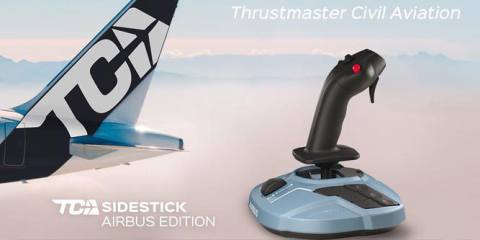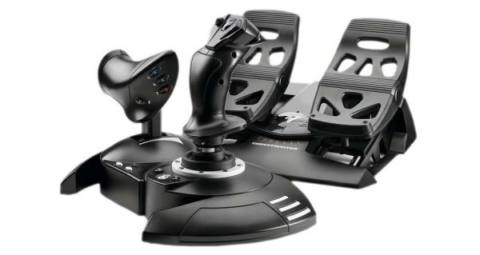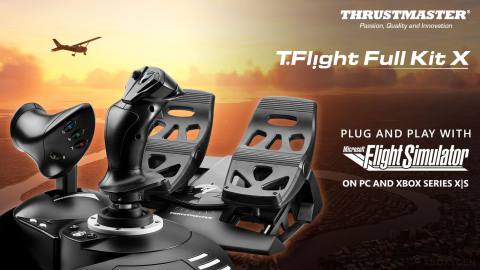Microsoft Flight Simulator is magical no matter how you play – but it definitely gains a little something special if you use the proper sim hardware.
If you’d asked me who all those specialist flight simulator peripherals were for before the new version of Microsoft Flight Simulator launched, I would’ve just said, y’know, actual pilots, or pilots-in-training. The hardcore flight simulation people. The nerds. That description probably isn’t inaccurate. But beware of how blissfully brilliant Microsoft Flight Simulator’s latest outing is: it’ll turn you into one of them too.
I used to look at all this specialist hardware with curious bemusement. I’d visit the Mad Catz meeting room every E3 to hear the latest updates in the world of arcade sticks, but I’d always breeze past the massive, Saitek full cockpit demo machine. It was always enough to make me stop and go ‘this is cool’, but never enough to get me to buckle up for a test flight.
What I needed, I suppose, was an accessible, impressive game. The sort of thing that can make a flight simulation convert out of even the most clueless would-be pilot. The new game from Xbox and Asobo Studio is exactly that, but it’s also an experience vastly enhanced by the peripherals on offer. So now here I now am, with my office cluttered with flight sim peripherals and a burgeoning Amazon wishlist of other add-ons I fancy.
Don’t get me wrong – this is an expensive business. For most significant additions that’ll level up your flight sim experience you’re looking at at least $100 an item – and if you want to get into more premium and therefore more satisfying stuff, that number can double or even triple. For pedals, the item most in need of hardier build-quality, you could stretch to over $500. This stuff is big business.
That explains reports from Flight Sim’s launch suggesting that the game would go on to drive $2.6 billion in new hardware sales. Prior to playing Microsoft Flight Simulator I would’ve been shocked by this, but now I’m not at all. Given so much of this technology comes piecemeal, it can be a slippery slope to spending four figures – but it also handily means you can just buy the bits you care about, or just buy a basic all-in-one kit.
- The best budget all-in-one Flight Sim gear for PC & Xbox
- Stand-alone Flight Sim Yokes & Joysticks
- Stand-alone Flight Sim Pedals
- Modular Panels for Flight Simulator
The best budget all-in-one Flight Sim Solution
Flight Sim accessories can be basically split into a few key categories. There’s Yokes and Joysticks, Pedals, and Modular Panels. However, some options on the market work to give you an all-in-one solution at the lower end of the budget.
One of our favourite picks in this category, and available both for PC and Xbox, is the Thrustmaster T.Flight Full Kit. This includes everything you need for a complete flying experience. The most important part of the kit is a full high-precision HOTAS joystick – HOTAS stands for Hands on Throttle and Stick. That means that it’s a two-handed setup where one hand is used for the joystick and the other is used for the throttle. Both have a variety of buttons for toggling other settings. Also included are the Rudder Pedals, which are vital for realistic control of many types of plane found in Flight Simulator.
The Xbox version of this stick is called the T. Flight Full Kit X, and it’s functionally identical – but of course is plug-and-play Xbox compatible and features the various Xbox button iconography for a slightly higher price tag of around £150 – though scalpers are currently driving that up as a Flight Sim hardware rush continues to occur.
If you’re not bothered about the pedals, the Thrustmaster T.Flight HOTAS can also be had separately – for a much cheaper cost, for around £60-£75, depending on your choice of platform. This is actually the better package if you’re more interested in playing slightly simpler games, like Star Wars Squadrons. For Flight Sim we’d recommend the pedals, however – they really add something to the experience.
If you’re all-in on having pedals, the T.Flight Full Kit bundle is by far and away the cheapest way to get everything you need. The only downside is that it is of course a flight stick – not a yoke. If you prefer a yoke, you’ll have to get ready to spend a little more…
Stand-alone Yokes & Joysticks
The first key accessory you’ll want to start out with is a more natural input device for the basic controls of your aircraft. I’ve tried out three: the Honeycomb Aeronautical Alpha Flight Controls, the Logitech Pro Flight Yoke System and the Thrustmaster TCA Sidestick Airbus Edition. All three are great – and as listed, these three range down from the most expensive and luxurious to the most simple, cheap and cheerful.
The Honeycomb Aeronautical yoke is a thing of beauty. It’s solid as a rock, beautifully crafted and just feels great to hold and use. You can pair this with a keyboard and enjoy flight sim quite freely — the keyboard part isn’t realistic, but the most difficult element of flying – keeping a plane level and steady – becomes so much easier with a yoke it isn’t funny. This is the most expensive of the three, however, and it also doesn’t come with a throttle section, leaving that to the keyboard.
Honeycomb also has an equally lavish throttle that is a joy to use, while Xbox-compatible peripherals are also inbound later this year. The Honeycomb gear is by far and away the best and my favourite of the stuff I’ve tested, and I’m keen to see how their Xbox options pan out.

The Logitech Pro Flight Yoke System is actually technically a Saitek product; when Mad Catz was self-destructing, the previously-mentioned Saitek brand was plucked from them by the PC accessory experts at Logitech. It’s flimsier than the Honeycomb device but still quite impressive-feeling, a large thing that’ll dominate your desk while imparting a real boost to the realism of the simulation.
It also comes with a throttle, which makes this a particularly friendly and attractive all-in-one package for the basics. For multi-engine aircraft you can also pick up a second throttle relatively cheaply – it all then connects together to give you an extremely comprehensive basic control setup. This is also one of the few parts of the Logitech flgiht sim peripheral range that is presently instantly recognized in Flight Simulator for easy use, however – more on that later.

Finally, there’s the more traditional and potentially more widely useful option: a joystick, often properly referred to in aviation as a sidestick. This still more accurately delivers on the sensation and specifics of flying, but it is worth keeping in mind that most of the aircraft featured in flight sim use a yoke, so it generally won’t be cockpit-accurate. With that said, joysticks are a lot less intricate than yokes – which makes them cheaper, as well as smaller and easier to store. If you’re not building a cockpit and are just playing flight sim at your PC desk with less space, it’s the ideal solution.
In testing, I tried out the Thrustmaster TCA Sidestick, a new release that’s covered in official Airbus branding. It’s a lovely piece of kit – sturdy, with a lockable twist rudder function. It’s more basic but also completely serviceable, and by its very nature as a joystick is more easily portable to other games. You could set this up in Elite: Dangerous, for instance, whereas a Yoke will feel less at home there – and that versatility is handy, and a fair trade-off for the flight-sim accuracy in yoke-controlled aircraft. Thrustmaster also has a matching Throttle on the way, releasing in around a month.
Pedals – the more serious Flight Simulator upgrade

The next step up from a yoke or sidestick is to pick up some pedals. Pedals control the rudder of the aircraft and in some intances some other functions – primarily they are for a steering assist. You’ll most keenly feel the addition of pedals before you take off, incidentally – they get a whole lot of use when you’re taxiing to your designated runway. Even in the air, however, they have a big impact.
Pedals are often the most overlooked flight simulator accessory, and not without good reason: they start at over $100 at a minimum, and they’re relatively boring when described; you press them with your feet and they help to steer the aircraft; big whoop.
But seriously: pedals are major. They’re equally as transformative of the flight sim experience as having a yoke or a sidestick, because it makes one of the most challenging aspects of flying – manuvering the aircraft smoothly – much easier.
Like I said, pedals range greatly, and most manufacturers have basic and heavy-duty options. The basic ones are mostly plastic in construction, and that means if you’re too overzealous you could break them. The heavy-duty pedals can take some serious punishment – but they come with a punishing price.
For instance, Thrustmaster has the T. Flight Rudder Pedals for a reasonable price – but if you’re willing to pay quadruple the price you get the heavy-set, sturdy and sublime Thrustmaster TPR Pendular Rudder – which is mindblowingly smooth to use.
Modular Panels for Flight Simulator

Probably the most attractive of all the flight simulator accessories are the modular panels that can be used to expand your sim experience by bringing pieces of the in-game cockpit into your real-life setup. King of these products, an industry standard, is the Logitech G Saitek Pro Flight Instrument panel – a staple of hardcore sim fans for many years.
These actually didn’t work in the launch version of Microsoft Flight Simulator on PC without big modifications – but in the months following, the game has been patched to natively accept and run with these various instruments, which can be usefully stacked and screwed together to produce a panel of real-time readouts you can use mid-flight.
There’s a number of these panels, including the Instrument Panel (which you can have multiple of to bring flight instruments into the real world), the Multi Panel (for controlling auto pilot, flaps and more), the Switch Panel (featuring engine ignition, landing gear and many other cockpit controls) and the Radio Panel (for chatting to ATC more naturally) – and all are now compatible with the PC version of Flight Sim.
This is a fast way to spend a whole lot of money, as it’s easy to find use not just for one of each panel, but multiples of some of them, especially the Instrument Panels. They’re attractive, functional, and just… cool, but they are certainly an accessory more aimed at the serious, hardcore simmer. With that said, even if you’re perfectly happy flying with an Xbox controller – a completely valid way to play – you can get some joy out of having your altitude or other instruments displayed in front of you, but off-screen, which is what these accessories allow.
The post Flight Simulator hits different with the specialist controllers – so here’s the best ones appeared first on VG247.








